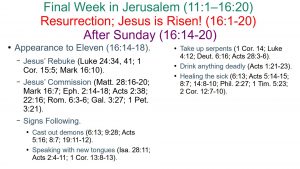Jesus’ Final Week in Jerusalem
Mark 11:1–16:20
Teaching (11:1–13:37)
King (11:1-11)
Sunday: Triumphal Entry (11:1-11).
Lawgiver (11:12–12:44)
Monday (11:12-19).
Tuesday (11:20–14:2).
Prophet (13:1-37)
Trial (14:1-72)
Sacrifice (14:1-26)
Wednesday (14:3-11).
Thursday (14:12-72)
Betrayed and Killed (14:27–15:47)
Death (15:1-47)
Friday (15:1-47).
Resurrection (16:1-20)
Jesus is Risen!
Sunday and Later (16:1-20).
Jesus’ Resurrection (16:1-8).
Question on Validity of the Following (16:9-20).
First Appearances (16:9-13).
Appearance to Eleven (16:14-18).
Jesus’ Rebuke (16:14).
Jesus’ Commission (16:15-16).
Signs Following (16:17-18).
Signs follow whom?
In My name.
Cast out demons.
Speaking with new tongues.
That leads us to the taking up of serpents, something that is practiced as part of the worship service for some extreme forms of Pentecostalism in Appalachia.
The Apostle Paul, in his first letter to the Corinthians, tells the people there that they were not to speak in tongues in worship for show.
It was to be done in an orderly fashion if at all (1 Cor. 14).
That does not characterize modern speaking in tongues, nor does it characterize snake handling in worship today.
As Jesus quoted when He was tempted by Satan, “You shall not tempt the Lord your God” (Luke 4:12; Deut. 6:16) – that’s precisely what this practice does!
In any event, we do have an example of this happening to someone in Scripture—the Apostle Paul (Acts 28:3-6).
Did he take this serpent up while worshiping? No, this was an accidental occurrence. He had no intention of getting bit, but he was and it helped the natives of Malta to listen to him and trust him.
And I can’t tell you how many times these modern snake handlers get bit, and sometimes die, many of them preachers—it’s a farce.
Drink anything deadly.
Some of these snake handling churches will intentionally drink poison, too.
But of course the same rules apply, that we should not tempt the Lord our God or make a show of His miraculous work (assuming we could today).
This is the one thing that we cannot find happening in the biblical record.
The idea is that one might drink poison accidentally or forcibly as a death sentence, similar to how Socrates was sentenced to drink hemlock.
There is one brief mention in the writings of Papias from the mid-second century of someone who did drink poison and was okay: Justus Barsabbas.
He was mentioned as one of the ones who was a contender to replace Judas Iscariot as an Apostle (Acts 1:21-23), though Matthias was chosen.
He apparently was a follower of Jesus since He was baptized by John, and he was also a witness of the risen Lord.
Of course, who knows how much of this was legend or fable by this point?
Healing the sick.
Finally we see again something the disciples themselves had done previously (6:13).
These weren’t “faith healings” like you have today—these were legitimate miracles.
There were, of course, many instances of this in Acts as well by people like Peter, Philip, and Paul (Acts 5:14-15; 8:7; 14:8-10).
But it wasn’t a blanket ability—Epaphroditus was sick to the point of death (Phil. 2:27), Timothy had a stomach issue (1 Tim. 5:23), and Paul had his thorn in the flesh (2 Cor. 12:7-10).
This is one of the most common miracles shown in the Scriptures, if you can ever call a miracle common, and yet not everyone was healed.
And the reason is seen a little later in 16:20.
